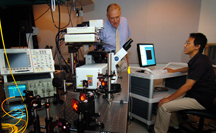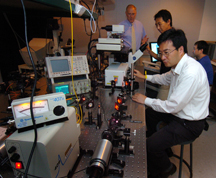Purdue researchers develop technology to detect cancer by scanning surface veins
2007-09-19
A new technology for cancer detection that eliminates the need for drawing blood has been developed by Purdue University researchers.
Researchers from Purdue's Cancer Center, Department of Chemistry and Weldon School of Biomedical Engineering collaborated with cancer and biotechnology experts from the Mayo Clinic to develop technology to detect tumor cells within the human body. By shining a laser on surface veins, such as those on the wrist and inside the cheek, researchers are able to reveal and count circulating tumor cells.
In addition to being less invasive, the new detection method is able to evaluate a much larger volume of blood than what can be drawn from a patient for analysis, said Philip Low, Purdue's Ralph C. Corley Distinguished Professor of Chemistry.
"In the initial stages of cancer, there are very few circulating tumor cells - cells that indicate the spread of cancer and initiate secondary tumor formation," Low said. "By increasing the volume of blood analyzed, we improve the sensitivity of the test and allow for earlier diagnosis. If there are two cancer cells in every 50 milliliters of blood, odds are the cells would not be found in a 10-milliliter blood sample. However, the cells would be found in the 100 milliliters of blood that flow through large veins each minute."
Optical imaging provides high resolution and chemical specificity for cancer detection, but it usually suffers from limited penetration depth, making it hard to reach tumors inside the body, said Ji-Xin Cheng, an assistant professor of chemistry and biomedical engineering.
"In vivo detection of circulating tumor cells in surface veins provides an excellent way to overcome this problem," Cheng said."Circulating tumor cells provide a benchmark for disease progression and precise monitoring of their levels could lead to personalized treatment," Low said. "Thi

Philip Low and Wei He (seated) 
Ji-Xin Cheng (foreground),
Wei He, Philip Low (left),
Haifeng Wang (right)